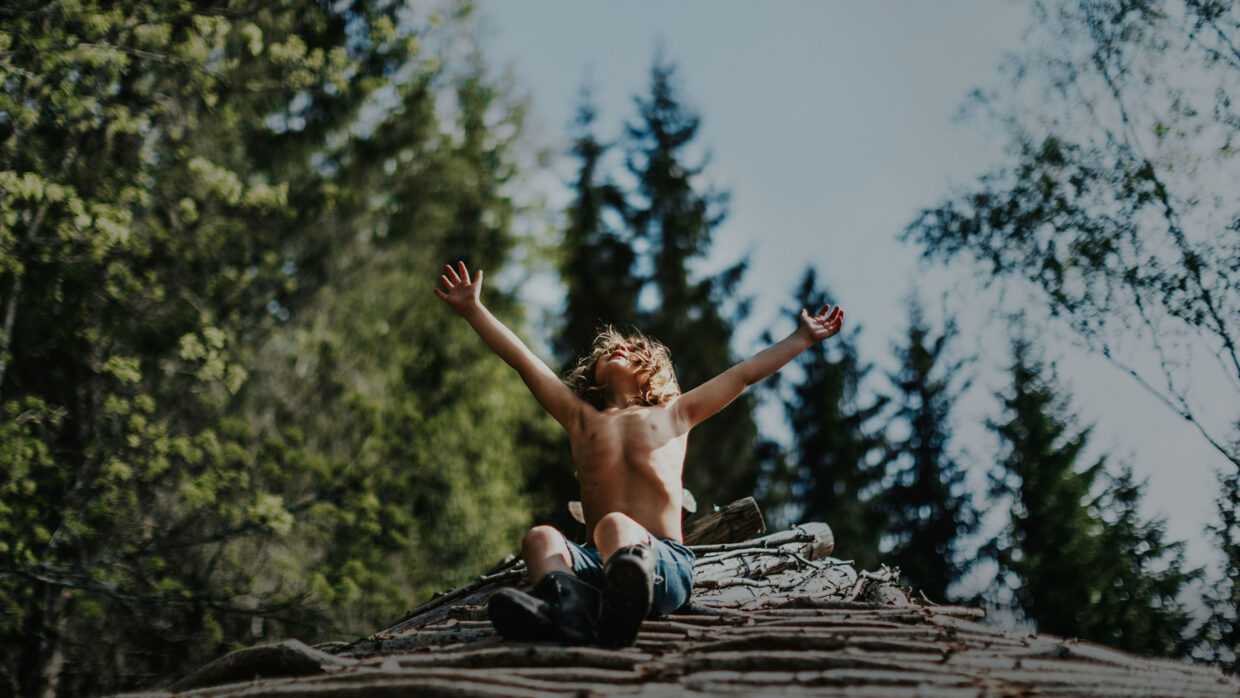 Back to selection
Back to selection
“My Shooting Process Involved a Mix of Planned Setups and Spontaneous Captures….”: Silje Evensmo Jacobsen on Her Sundance-debuting A New Kind of Wilderness
 A New Kind of Wilderness Photo by Maria Gros Vatne.
A New Kind of Wilderness Photo by Maria Gros Vatne. Silje Evensmo Jacobsen’s A New Kind of Wilderness is a film structured in a way I’ve not seen before. With a title that likewise could apply to the psychic space into which the audience is thrust, the rural Norway-set doc is an intimate, first-person narrated, cinematic essay from a director whose story it is not. Indeed, straight from its bold opening, the viewer is left abruptly disoriented, forever second-guessing whose eyes we are actually looking through. It’s a deft structural feat that in turn emotionally transports us into the shoes of the free-spirited, forest-dwelling – and above all grieving – Payne family, five protagonists deeply connected both to one another and to nature; who are unexpectedly forced to find their own individual footing in a brand new dizzying world.
Just prior to the film’s Sundance debut (January 19th in the World Cinema Documentary Competition), Filmmaker reached out to the award-winning Norwegian director to learn all about her multiyear voyage into the beautiful unknown.
Filmmaker: At what point did you enter into the lives of this family? Had you known the Paynes long before filming?
Jacobsen: Almost a decade ago a friend introduced me to Maria’s blog, wildandfree.no. Her captivating photos and stories inspired me; I could see this family’s journey as a TV series.
So I reached out to Maria, and we instantly connected upon meeting a few days later. She warmly welcomed me into their lives. I filmed the family, produced a two-minute pilot, and though the series didn’t materialize Maria and I stayed in touch. Unfortunately, I didn’t film anything further until reuniting with the family in 2019. By then around a decade had passed, and Maria was no longer with us.
Filmmaker: Could you talk a bit about how you came up with the doc’s ingenious structure? Not to give away any spoilers, but despite this being a first-person-narrated, cinematic essay you’re not a character in it because this isn’t your story.
Jacobsen: I initially planned to use Maria’s photos and stories as the backbone for the film’s structure. The concept revolved more around connecting her stories and photos to each child’s present experience, cycling through their perspectives over a year. The aim was to discover loss from the children’s viewpoint while observing their interactions with nature, their relationships within the family, and the substantial changes in their lives.
However, I soon realized the need for a longer timeframe. I decided to focus on the two girls, Freja and Ronja, and their individual processes and relationship. Nik, navigating life as a single parent and making crucial decisions, also took on a bigger role. They, alongside Maria, became the primary characters.
And though this made for a rather complex narrative, it felt like the most genuine way to tell this story. I assure you, putting together the puzzle for the final edit was a lengthy and intricate journey.
Filmmaker: The film is such an intimate collaboration with young children and a protective parent going through a difficult time. So how did you ensure everyone’s emotional wellbeing throughout?
Jacobsen: Determining when it was appropriate to film and when to give space required careful navigation; establishing a strong relationship with the family was crucial. We maintained open communication, so when they found filming challenging they felt comfortable expressing that to me. This led to meaningful discussions, and also extended breaks from filming when necessary.
Spending time with the family off-camera was equally important to me. It allowed me to build a deeper connection, to understand their journey, and to respect their emotional process.
Filmmaker: I’m also curious to hear what those discussions were like about when and where the camera would be allowed. Did all the participants have a say in the final cut?
Jacobsen: My shooting process involved a mix of planned setups and spontaneous captures that just felt right in the moment. I had some clear ideas in my head, but I’m also interested in those natural unexpected scenes that unfold. Often I just spent time with them being open to what was to come. Sure, there were times I might have overstepped, but they let me know; and that sparked some good chats and helped us to understand each other better.
They did have a say in the final cut, but there were no significant issues. Getting those important moments was all about the trust they placed in me, letting me be a part of their lives and knowing I’d handle any sensitive aspects with care. Making sure they felt safe to share, even if it was tough, was crucial to me. I wanted them to know I’d always respect their limits during and after shooting.
Filmmaker: I was likewise left wondering how you determined when it was time to stop shooting. Did external factors come into play? Though the doc ends organically, it also felt like it could have been a series (a format you’ve worked in before).
Jacobsen: Honestly, I could have continued to follow them for a couple of years and been involved in big turning points in their lives – especially the children’s. However, my first idea was to film them for a year; when production continued for over three years, we agreed that it was time to stop. They had overcome the toughest time in their lives and were ready to move on – and that also involved finishing the process of the film. Which I totally agreed with and respected.
